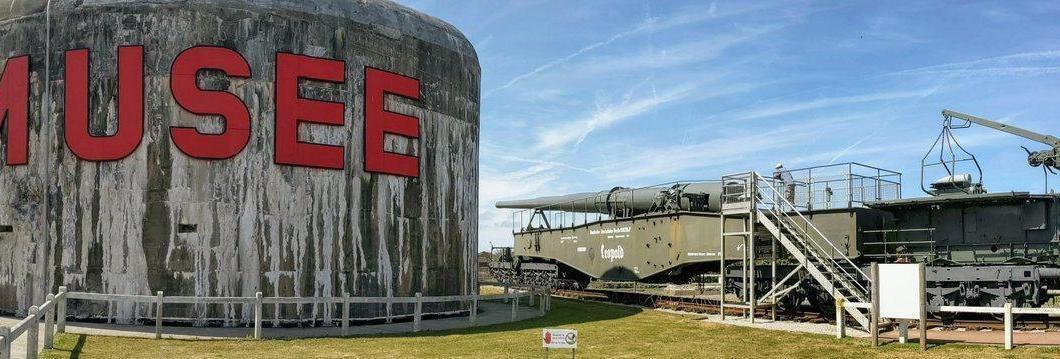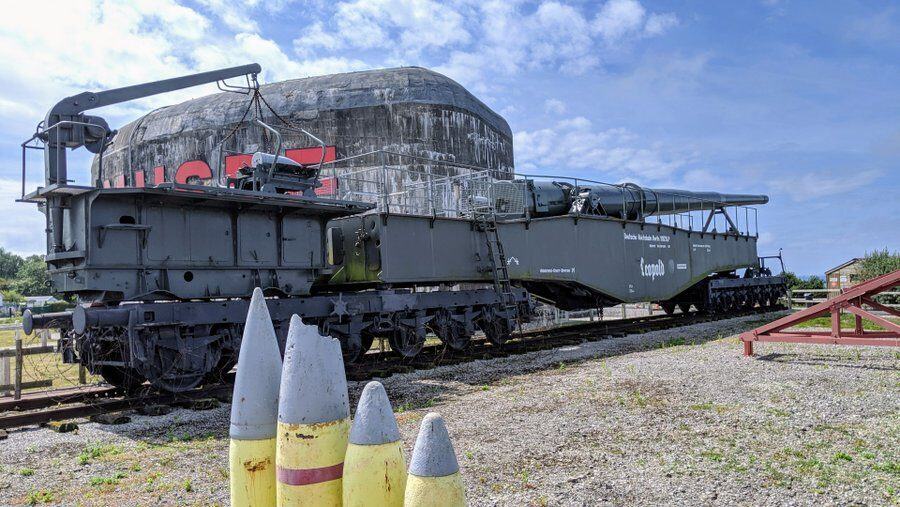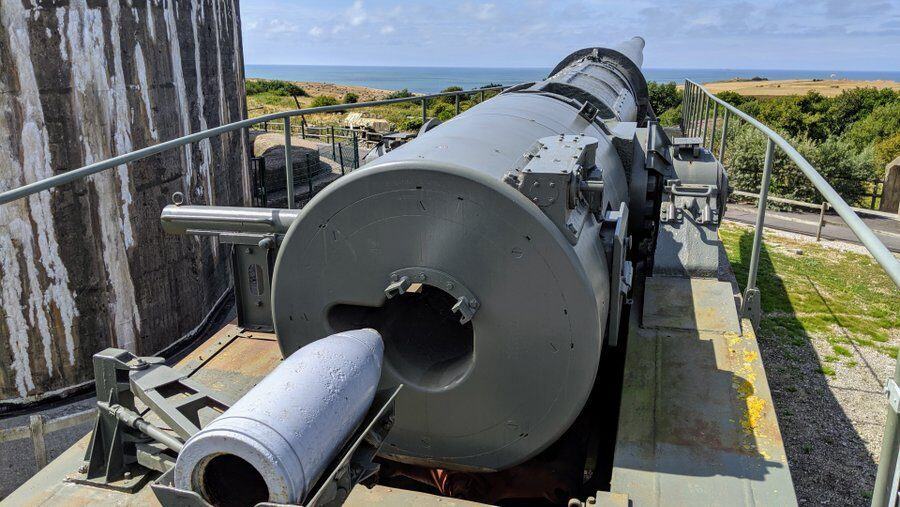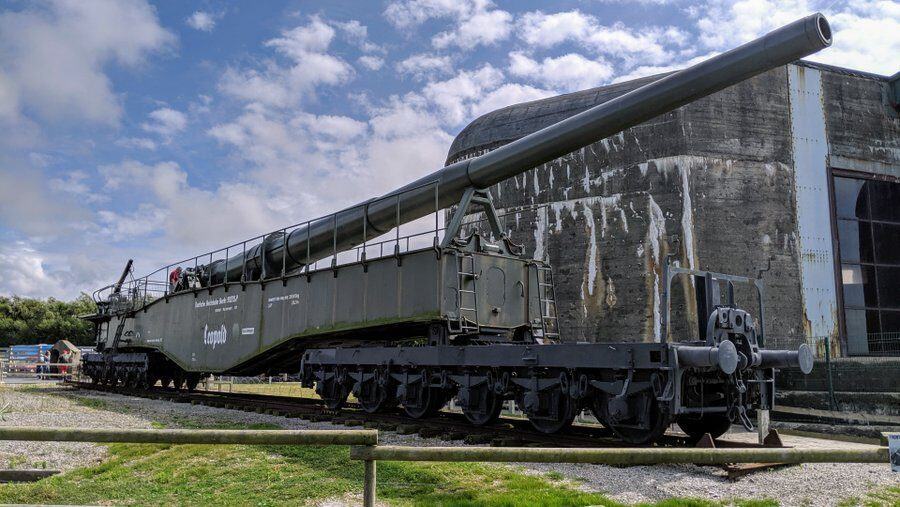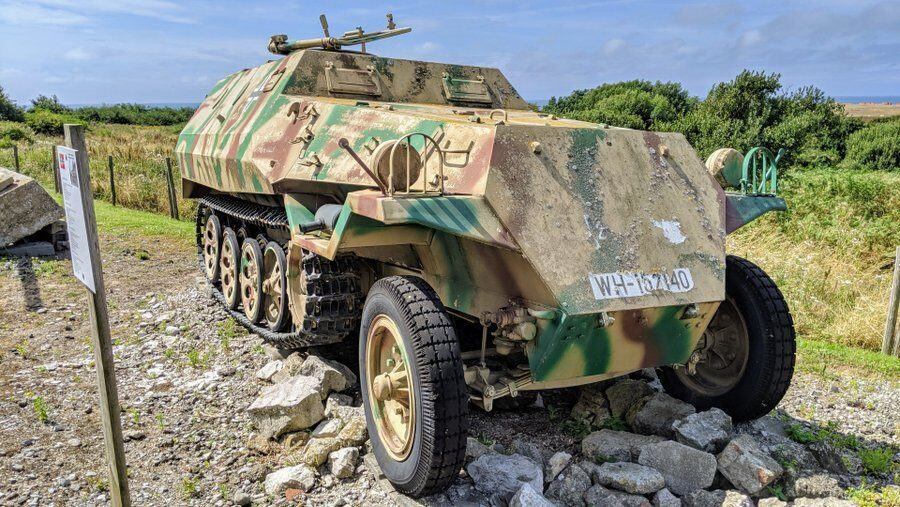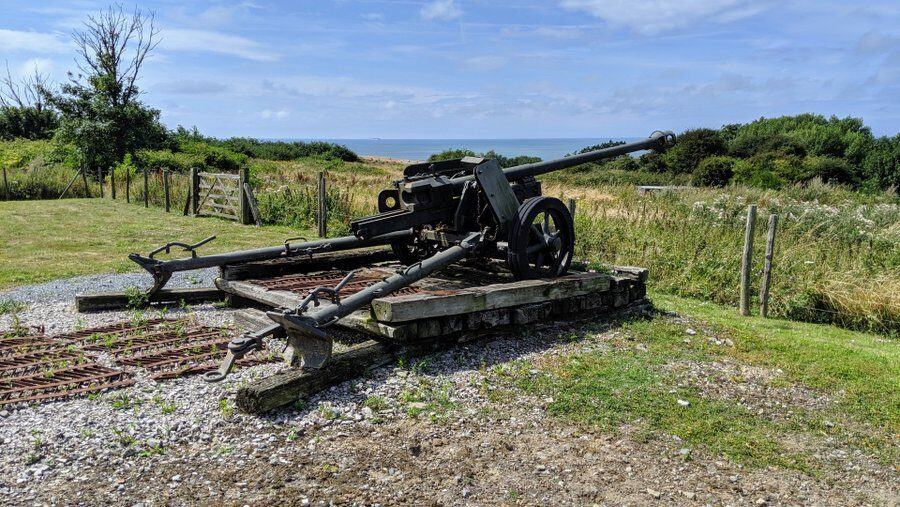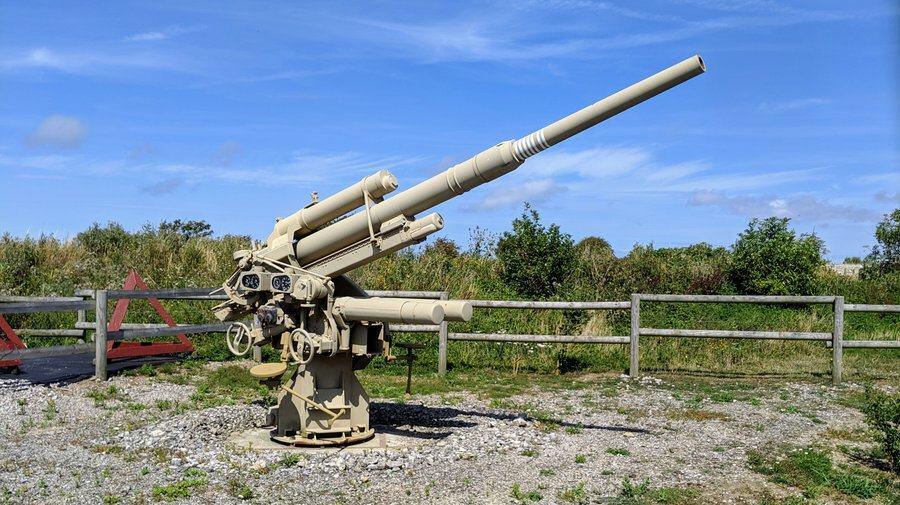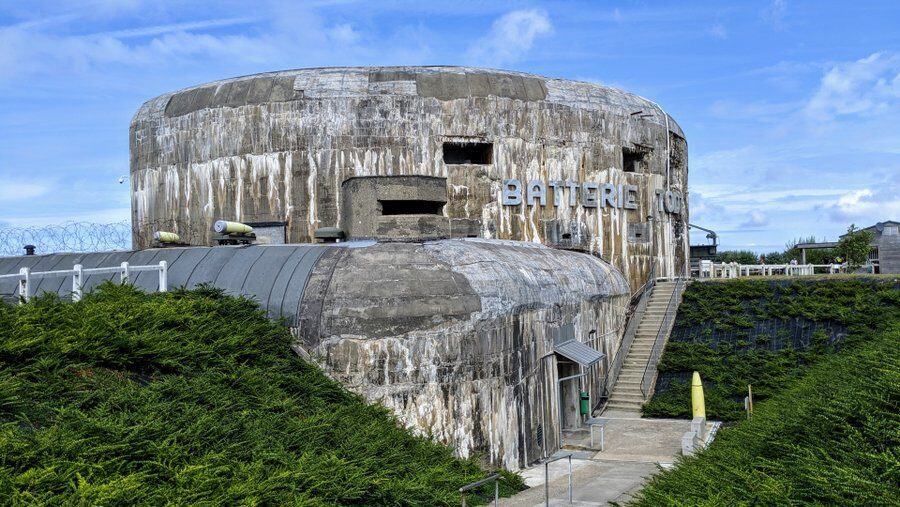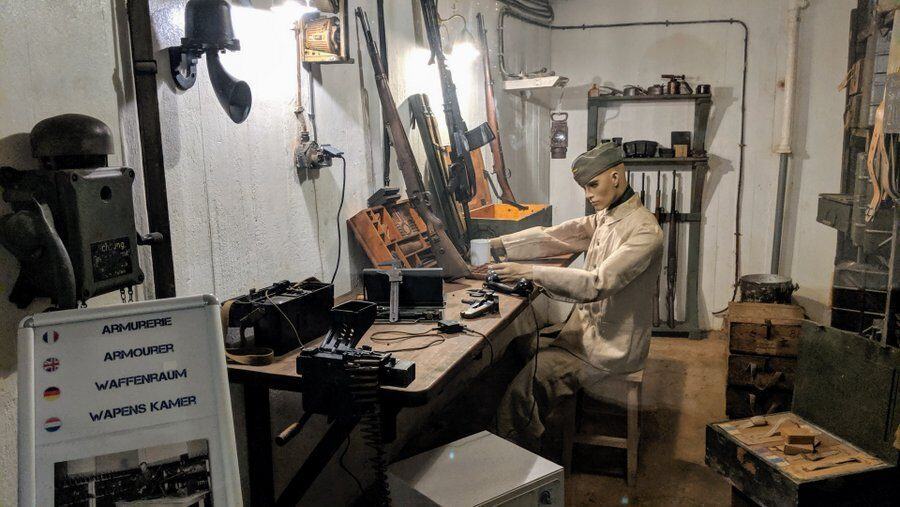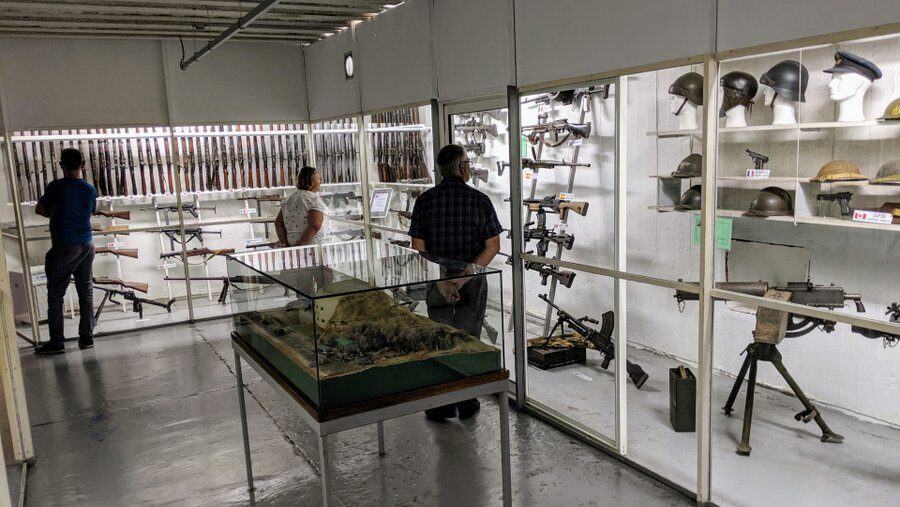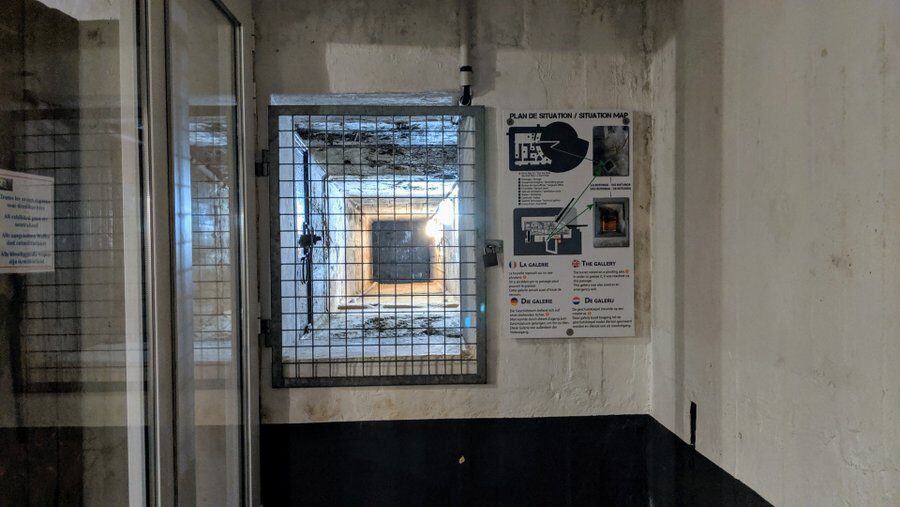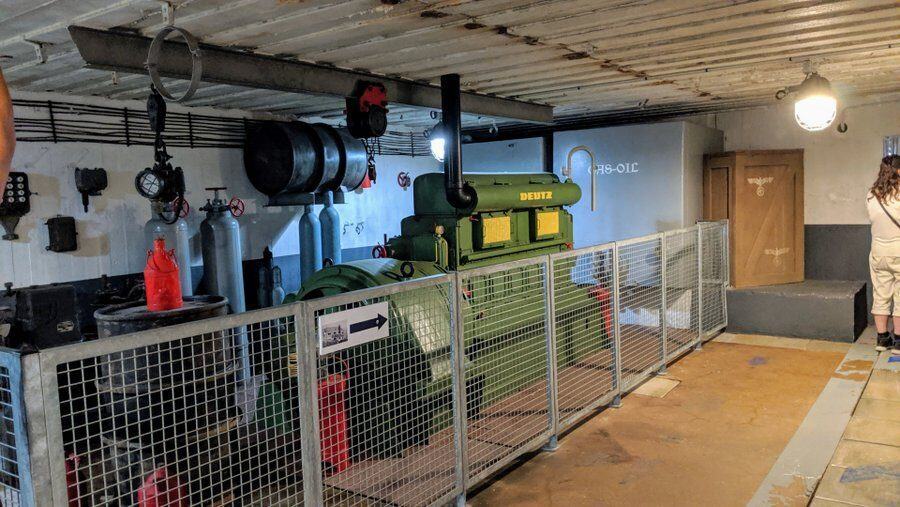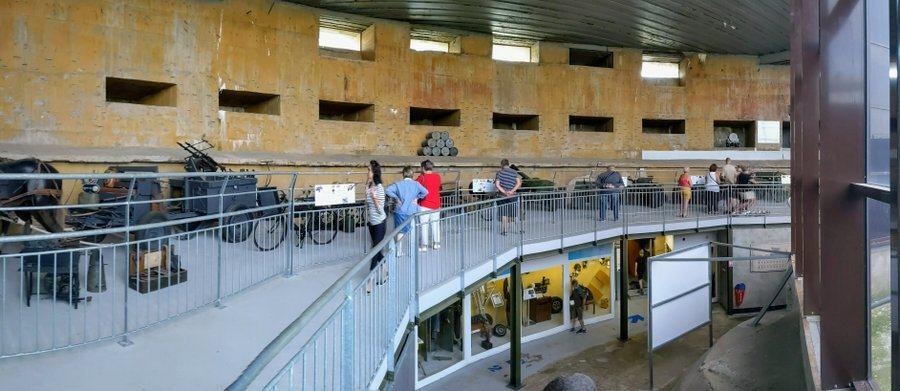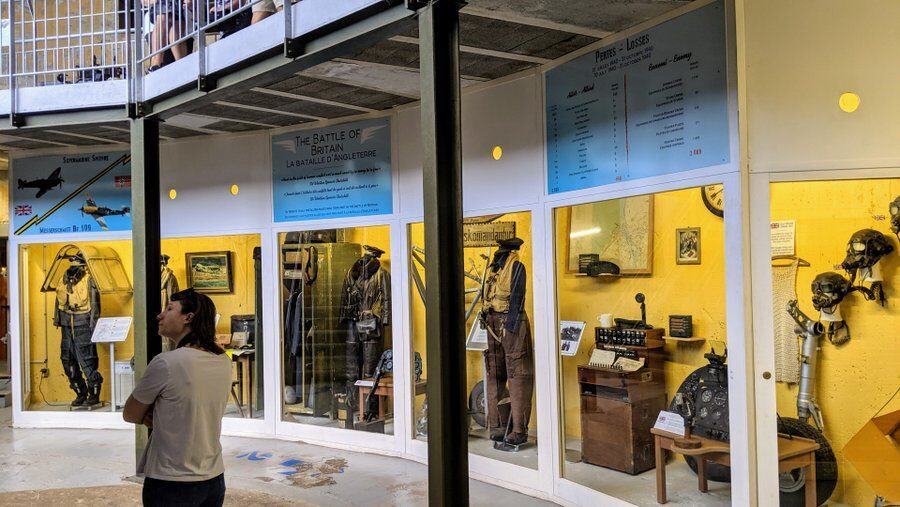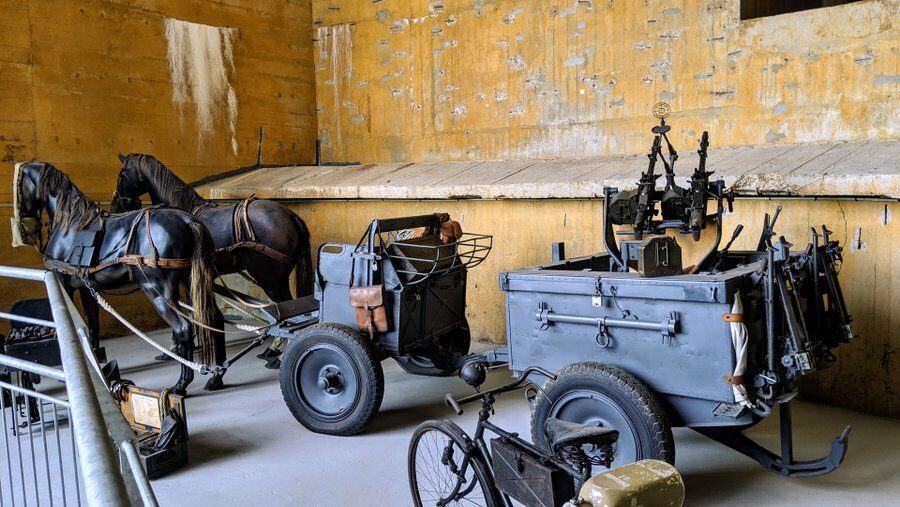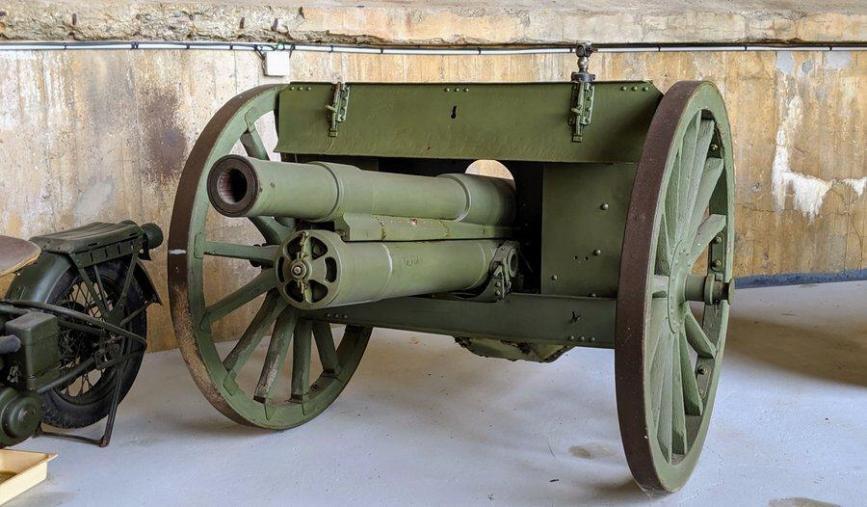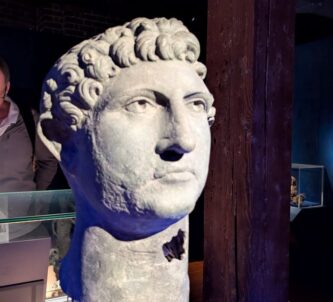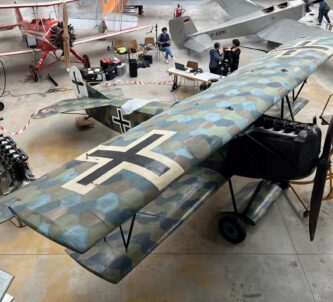The Museum of the Atlantic Wall, aka ‘Batterie Todt’, is all about the big guns!
Not only was the giant concrete casement built specifically to accommodate a massive gun, it now has one of the two remaining German K5 railway guns parked alongside as a major exhibit.
It’s important too, to recognise that it should be called “Turm 1 of Batterie Todt” because, although it stands out by itself on the coast road, it is just one of FOUR such casements (“Turm”) built near the hamlet of Haringzelles near Cap Gris Nez. The other three are in various stages of decay, hidden away mostly in undergrowth within 650m.
The History of Batterie Todt
The museum in Turm 1 is called the ‘Museum of the Atlantic Wall’ but it only became a part of the Atlantic Wall later. It’s original purpose was offensive, not defensive.
As his army swept into France in 1940, Hitler started thinking about crossing the Channel and ordered his senior command (OKW) to start drawing up plans for the invasion of Britain (Operation Sea Lion). Those plans called for heavy artillery cover for the invasion fleet, which would be used to keep the Royal Navy at bay and ‘soften up’ the landing area.
For that they needed some big guns, and since they had recently cancelled a programme to expand the German surface fleet, they had some spare naval guns looking for a job.
Within a month, Organisation Todt got straight to work surveying and preparing suitable sites on the coast at Pas-de-Calais.*
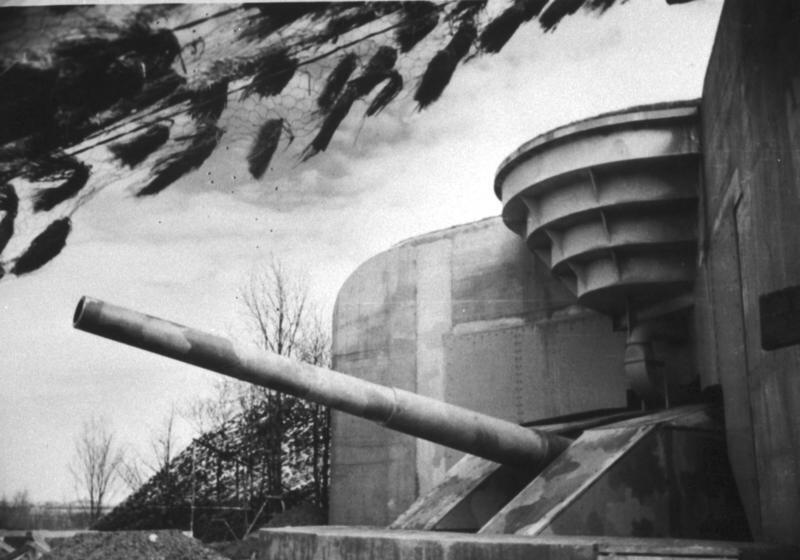
Four 380mm (15″) guns manufactured by Krupp, the same as those used on Bismark & Tirpitz and previously destined for a programme of capital ship new builds that Hitler had cancelled, were reallocated to this battery to be built at Haringzelle a tiny hamlet outside Audinghen, near Cape Gris Nez, and named Batterie Siefried. Construction started in July 1940 and the battery fired its first shells on 20 Jan 1942.
The battery was inaugurated on 10 Feb 1942 in the presence of Grand Admirals Raeder and Dönitz, and renamed Batterie Todt in honour of Fritz Todt, the head of the Organisation Todt who had died in a plane crash two days earlier.**
The battery was called to action stations almost immediately. The day after the inauguration, the German battlecruiser Scharnhorst with her sister ship Gneisenau*** and the heavy cruiser Prinz Eugen, broke out of Brest and began their famous high-speed ‘Channel Dash’ back to Germany. Obviously Raeder and Dönitz knew. Perhaps that was why they were there? The capital ships and their escorts passed Cap Gris Nez and under the protection of Batterie Todt around lunchtime on 12 Feb.
Batterie Todt’s four 280mm guns each weighed 110 tons and their crews of 4 officers & 18 men could fire an 800kg (1763 lb) shell every 30 seconds to a max range of 55 kilometres (34 miles). The flight time for a shell to reach Dover was 42 seconds, and from the time they became operational to their capture, the four guns fired roughly 200 shells each.
There’s a good summary of the cross-Channel shelling from both sides in a Medium article.
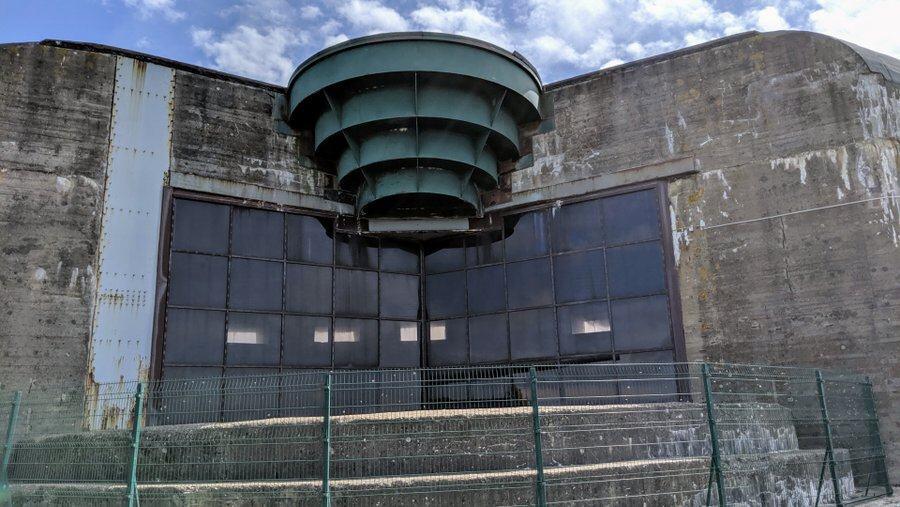
After the Normandy breakout in the summer of 1944, the First Canadian Army started northward to clear up the ports, harbours and defences along the French Atlantic coast.The coastal batteries around Cap Gris Nez were allocated to the 9th Canadian Brigade with armoured support from the 1st Hussars (6th Armoured Regiment) and flail tanks, Churchill ‘Crocodile’ tanks, and Armoured Vehicle Royal Engineers (AVRE) tanks from the 79th Armoured Division. These were very suitable forces since from the landward side these huge casements were protected with minefields, bunkers, tobrucks, trenches and barbed wire. The flail tanks could easily carve a path through the barbed wire and mines, while the terrifying Crocodile flame throwers could deal with the bunkers and the AVRE petards could lob a 290mm mortar (nicknamed a “flying dustbin”) against any thick wall****.
The attack started with a 532 RAF bomber raid on the 26th September 1944
Afterwards, Lieutenant-Colonel DF Forbes of the North Nova Scotia Highlanders who were tackling Batterie Todt, distinguished himself by knocking on the door of the nearest Turm and warning the garrison that he was equipped with all these specialist tanks. It didn’t trigger an immediate surrender, but when the assault proper began at 0645 on 29 Sep with a creeping artillery barrage (including accurate and disabling counter battery fire on Batterie Grosser Kürfurst from Dover), it didn’t take long (1030) for the defenders to raise white flags.
Visiting the Museum of the Atlantic Wall
From the entrance you are led naturally to the outside exhibits, starting with a German 88mm flak gun and a display of artillery shells, but all this is dominated by the…
The Krupp K5 (E) Railway Gun
The K5 (E) or Kanone 5 (Eisenbahn, ‘railway’) is an interesting gun that has its roots in WW1 when railways, branch lines and sidings were the arteries and veins that fuelled the battlefield.
In the post-Beeching era it’s easy to forget that at their peak the railway networks in Britain & Europe went everywhere and delivered the men, weapons and supplies to whichever part of the battlefield they were needed. Remember, when the armistice was signed it wasn’t in a hotel or chateau, it was in a railway carriage on a spur of track in a wood near Compiègne.
Remember too that, as it had been in the First World War, the German army was still largely un-mechanised. Railways were still the primary means of transport.
So, for delivering heavy ordnance the railway gun was a common solution. Us Brits had them, the French had them, the Americans had them in the Civil War… and they were still in the mindset of German military planners in 1941 when Krupp Steel built 21 x K5 (E) rail-mounted 288mm (11″) naval guns.
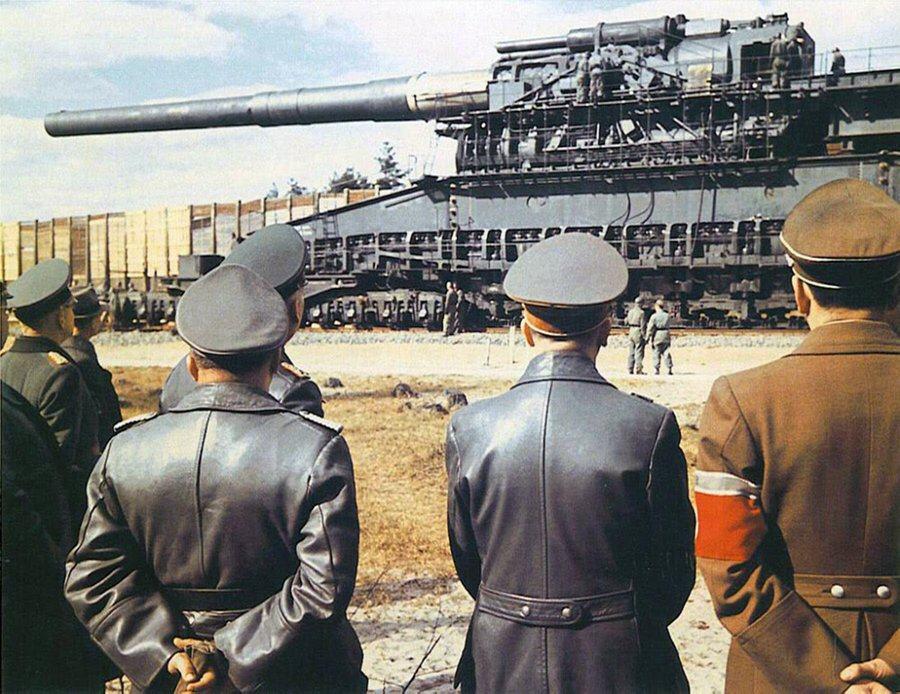
They are not the largest railway gun used during WW2. The 800mm German Schwere Gustav 800mm railway gun (designed specifically to tackle the Maginot Line fortifications) was on a different scale altogether!
The answer to your next question…
How did they aim it?
Well, some railway guns had swivel mounts, but as you can see the K5 (E)s didn’t. They could pan the gun through one degree of arc (for fine tuning the aim), but they had to use the curve of the track they were on.
“Wait! That’s a bit restricting isn’t it?”
Yes, but they didn’t just rely on finding suitable bits of track within range of their target (preferably with a nearby gully or tunnel in which to hide), they sent out railway engineers to key locations to pre-configure optimally curved sections of track.
When France was overrun in 1940 six K5s***** were sent to Pas-de-Calais where they made use of abandoned French railway turntables for targeting. Unlike their fixed battery neighbours manned by naval artillery crews, they couldn’t target shipping. They were there to shell Kent.
Later, in 1944, two K5 guns, ‘Robert’ and ‘Leopold’, were used to shell the landing beaches at Anzio, where they gained a fearsome reputation. Allied soldiers thought there was only one gun shelling them. They referred to it as “Anzio Annie” or “Anzio Express”. When the Allies gained ground, the guns escaped to the rail yard in Civitavecchia, where they were sabotaged by their crews.
Now, this is the odd bit. There are only two K5 (E) railway guns left in existance. Both are painted up as ‘Leopold’.
According to some reports, the American military took both guns to the army proving grounds in the USA where they repaired one of them (which?) and it ended up parked it in a siding at Fort Lee Virginia, where you can see it now.
The report that I believe¹ suggests that only ‘Leopold’ was shipped to the States and the other ‘Robert’ ended up here at Batterie Todt. If ‘Leopold’ is either of them, it is almost certainly the one at Fort Lee.
If you want more detail on how the K5s were crewed and operated, MilitaryFactory.com covers it well.
Also outside at the Museum of the Atlantic Wall
Caution – it’s possible some exhibits may have been removed, added or moved around a bit over the winter & COVID-19 shutdown.
As you walk around the front of Turm 1 there are several things on display including examples of the beach ironmongery (defences) installed above and below the waterline to impede landings.
There’s a Czech version of the German Sdkfz 251 half-track, which is always good to see close up. (Secret: I never really understood how they work/ how you drive them!) and a German PAK 40 anti-tank gun (there’s a few of those in museums down in Normandy!)
The entrance to the bunker is around towards the back.
Inside the Museum of the Atlantic Wall
Obviously when the bunker was operational this was a warren of ammunition stores, workshops, barracks, and other rooms. Some have been recreated in dioramas, others have been re-purposed as museum galleries to display a range of artifacts and equipment, Allied and German.
It’s interesting to think of the mindset of those men working in these rooms in 1942 – running the generators, stocktaking in the stores, fixing up burnt hands from hot shell casings in the infirmary – when this must have seemed like an impregnable fortress. Then, just two years later, doing those same jobs knowing the Allies were on their way and would be soon knocking on the door. They weren’t a mobile unit, they couldn’t just make their escape. And one thing was for sure; nobody was coming to rescue them. It must have been really sombre down here!
The Rotunda
The trail through the galleries leads naturally into the huge gun room (these days they call it “The Rotunda”). It’s a giant space, 29 metres in diameter. The gun turret and gun have long gone, so there is only the concrete plinth on which it was mounted and now a steel mezzanine level used for display.
The space around the base is being used for a cabinet display on the Battle of Britain, while upstairs there are a number of field guns and a really interesting horse-drawn flak cart. People forget that the bulk of the German Army was horse-drawn in WW2 as it had been in WW1, but they didn’t take as many photos of that as they did of their modern mechanised equipment!
The rest of Batterie Todt
Some hardy enthusiasts still try to visit the three other Turms of Batterie Todt, but it’s not easy, not safe, and not to be advised. They are on private land and in a dangerous state, with lots of overgrowth, flooded chambers, and unstable floors & walls. Turms 2 & 4 are in poor condition. Turm 3 is just a pile of rubble. The story goes that in 1945 two French workmen were investigating it. They used a naked flame for illumination and accidently set off the ammunition still stored there.
If you want to see what condition they are in, do a search on YouTube. There are a number of people who have filmed themselves climbing through the derelict turms.
* Batterie Todt was just one of six major coastal batteries covering the Straits of Dover on the Pas-de-Calais coast. The others were:
- Batterie Lindemann (named after the recently killed captain of the Bismark) with three 406mm (16″) SK C/34 guns in casements outside Sangatte
- Batterie Grosser Kurfürst with four 280mm (11″) guns at Cap Gris Nez
- Batterie Friedrich August with three 305mm (12″) guns east of Wimereux (only one is left, just off Route de La Trésorie)
- Batterie Prinz Heinrich with 2 x 210mm (8.3″)guns at Sangatte
- Batterie Oldenburg with 2 x 210mm (8.3″) guns in Calais (1km NE of the ferry port)
** Something puzzles me about this. The decision to rename the battery could have been made in two days, but in the photograph of the inauguration there is the name Batterie Todt in massive stone or metal relief characters on the wall of the bunker. Really? How long did that take?
*** At the end of their dash, Gneisenau was due for a massive refit. She had been built with nine 280mm (11″) in three turrets but the plan was to replace these with six SK C34 380mm guns in twin turrets – the same guns as Batterie Todt.
**** In the event the AVRE Petard mortars couldn’t penetrate the Turms’ thick walls, but the concussion certainly ‘rattled some teeth’ and focused minds on surrender!
***** and one smaller K12 210mm (8.3″) high velocity railway gun with an astonishing range of 115 km (71 mi).
¹ South Africa Military History Organisation
Nord-Pas-de-Calais Posts
| Blockhaus at Eperlecques | La Coupole |
| Vimy Ridge | Memorial 14-18, Notre-Dame-de-Lorette |
| In the footsteps of Douglas Bader, St. Omer | Guide to Visiting St. Omer |
Declaration: No need. I made a private visit last season and paid for my entry to the museum.
Factbox
Website:
Batterie Todt
It’s in French, but if that’s an issue for you there’s always Google Translate!
Getting there:
Musée du Mur de l’Atlantique
Batterie Todt
Route du Musée
62179 Audinghen
France
Best to drive independently, or visit with a tour group. It’s easy to get to, if you take the coast road from Calais. You can drop by for a visit on your way to/from the ferry!
Entry Price (2020):
| Adult | €8.90 |
| Child (7 – 16) | €5.90 |
| Student | €7.50 |
| Family (2 adults + 2 – 5 children between 7 – 16) | €25.00 |
Opening Hours:
Post COVID-19: The museum reopened on 11th May. It is currently accepting visitors in the afternoons only, from 1400 to 1730 (last entry 1630), and with social distancing rules in place.
They are hoping to return to normal hours after 15th June, if the government permits.

